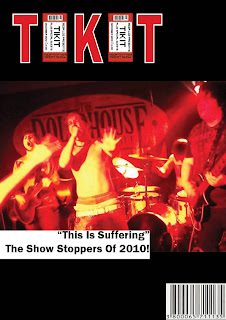The Front Cover.
I feel my front cover is quite conventional in comparison to other music magazines that I have researched and studied. My main image, I feel, challenges forms and conventions by using a live
 action shot of the band, whereas generally in magazines, there is a posed shot of the band offstage. As a live music magazine, I think this image is appropriate to the subject. I have included features such as banners at the top and bottom of the page. This is generally common within all magazines, and helps the page flow like a real product. Other features such as posters and competitions gives the feel of a more traditional magazine, with the main image being the exception. Small details have been paid attention to, such as barcodes, issue numbers, prices etc. This also adds to the feel of this being a traditional music magazine. I have taken inspiration from several different magazines, some of which are shown below.
action shot of the band, whereas generally in magazines, there is a posed shot of the band offstage. As a live music magazine, I think this image is appropriate to the subject. I have included features such as banners at the top and bottom of the page. This is generally common within all magazines, and helps the page flow like a real product. Other features such as posters and competitions gives the feel of a more traditional magazine, with the main image being the exception. Small details have been paid attention to, such as barcodes, issue numbers, prices etc. This also adds to the feel of this being a traditional music magazine. I have taken inspiration from several different magazines, some of which are shown below.
Double Page Spread.
I tried to create a new sense of exploration with my double page. As the article was about personal experiences from the view of a journalist, I thought a scrap book theme would be appropriate. I placed my images carefully to create a homely feel and help the reader relate to the article.

I tried to add small details such as page numbers and email addresses to make it more conventional. I used my masthead idea to make my page numbers, which I think has worked really well. I used bold, coloured writing in my article to emphasise parts of it that could possibly further engage the reader. I have seen this used in magazines before and thought it was a good element to include. I also saw the idea of the huge letter at the start of the article. I think this gives a depth to the page, and makes it look more like a real magazine. I included a snappy title for my article, which I think works well with the images and the article. Below are some examples of magazines I took inspiration from.
Contents Page.
I think my contents page is the most conformative of all of my pages. I tried to keep as much to forms and conventions as i could to make it look as real as possible.
These pages were mostly inspired by Q magazine. I tried to add every detail possible, such as names, email addresses, page numbers and even borders. The images, I feel, are placed well and it looks full and busy without looking cluttered and confusing. Below is a page i used as inspiration.



























